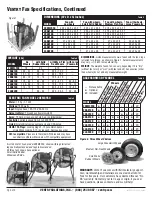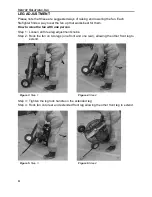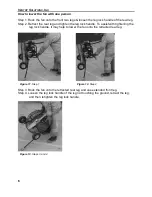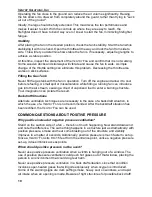
P
OSITIVE
P
RESSURE
V
ENTILATION
F
ANS
13
Figure 19. Ventry Fan legs are not symmetrical.
MAINTENANCE
Engine Maintenance
Refer to the engine manufacturer's manual.
Kevlar & Fiberglass-Coated Propeller
Propellers coated with Kevlar and Fiberglass are extremely resistant to wear and tear,
and require little to no maintenance other than occasional cleaning to maintain balance.
Some wear of the paint on the leading edge should be expected. If touch-up painting is
required, use a white polyurethane enamel. Be sure to balance the propeller before
placing it back on the fan to ensure that the fan does not walk
(see “Out-of-Balance
Propeller” in the Trouble Shooting section for more details). Significant damage, which
penetrates the fiberglass/Kevlar coating, may require evaluation by Ventry Solutions
.
Frame Maintenance
Wipe down the frame to remove dirt and grease buildup
The rubber leg ends (feet) will need to be inspected for wear. Damage, such as missing
pieces, may allow the fan to walk. Replacements may be obtained through Ventry
Solutions or at a local medical supply outlet.
Tachometer
Refer to the Tiny-Tach literature that came with the fan for general information. For
installation, refer to the diagram on page 20.
TROUBLE SHOOTING
Fan walks during operation
Worn out Rubber Leg Ends:
Look to see if the leg ends (feet) are worn out. If they
have a lot of wear, you may be able to rotate them on the end of the legs. This will
place a new section of rubber into service. Otherwise contact Ventry Solutions for a
new pair or you can pick up a new set at your local medical supply outlet.
Out-of-Balance Propeller:
An imbalance in the propeller can be caused by impact or
by abrasion. Light abrasion is considered normal wear and can be repaired by light
sanding and re-painting.
Propeller balance can be checked by inserting a 5/16 inch steel rod through the
propeller center hole. Roll the rod across two level parallel edges, making sure that
there is no breeze present while doing this procedure. The light portion of the
propeller will rotate to the top, which can be a tip, side, or anywhere in-between. Add
paint to the light portion or sand the heavy portion to balance the propeller. If you
have problems, contract Ventry Solutions.
Bent Frame:
V
ENTRY
F
ANS
are by no means symmetrical. If you
position yourself facing the front of the fan, the front leg on the left
should be angled several degrees ahead of the front leg on the
right. The front left leg also leans out more than the front right leg
does. These are design aspects engineered into the fan to
increase the stability and to prevent walking. Figure 19 gives you















































